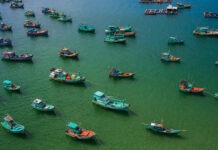Romania offers some of the most unspoiled wilderness on the continent, from the majestic peaks of the Carpathian mountains and the verdant, rolling hills of Bucovina to the extraordinary wetlands of the Danube Delta.
Its true charm lies in the variety of fascinating attractions in its urban centers – such as the capital, Bucharest, Braşov, Sighişoara, Timişoara and, most enchantingly, Sibiu. However, any exploration of rural villages will be rewarding, with sights as diverse as the log houses in Oltenia, Delta villages built of reeds, and the magnificent wooden churches, with their sky-scraping Gothic steeples, of Maramureş, not to mention the country’s more traditional churches, which reflect a history of competing communities and faiths.Here are some of the best places and regions to visit in Romania.

Bucharest: The Romanian capital continues to redefine itself, merging its storied history with a modern identity. At first glance, the architecture is dizzying, but it is a fascinating mix.
There are pristine city parks, excellent museums and gritty yet charming lanes that weave through the Old Town. The heart of the city is the Piaţa Revoluţiei, the scene of Ceauşescu’s downfall and site of the old Royal Palace – now home to the superb National Art Museum, housing a fine collection of Romanian medieval art.
North from Piaţa Victoriei, along the broad sweep of Şoseaua Kiseleff, lie Bucharest’s two best museums – the Museum of the Romanian Peasant, and the Village Museum, an assemblage of vernacular buildings garnered from Romania’s multifarious regions. There is plenty of greenery to explore, too – most obviously the tranquil Cişmigiu Gardens in the heart of the city, and the more expansive Herăstrău Park. You will not want to miss the vast Palace of the Parliament. This architectural colossus is known as the heaviest building in the world, the largest building in Europe (nearly four million square feet and one thousand rooms) and the world’s second-largest administrative building (after the Pentagon).
Bucharest is also swathed in beautiful parks. The oldest, designed in the mid-19th century, is Cismigiu Gardens, or there is the 400-acre Herastrau Park which features an open-air theater, as well as public recreation areas.

Danube Delta: The Danube Delta is one of the largest and best-preserved deltas in all of Europe, with 23 ecosystems that are home to a huge number of plants and wildlife. Located in Tulcea County in the Dobrogea region, the delta is a winding network of waterways that originate from the Black Sea. In total, the delta is 5,165 square kilometers, and it is listed as a UNESCO World Heritage Site.
A vast changing landscape of marshes and wetlands, the Danube Delta is home to some 360 species of birds and 160 types of fish. Whether you’re a bird watcher, or you just want to escape the bustle of the city, the Danube Delta is a natural paradise. You will find pristine beaches, incredible places to hike and also some of the best seafood in Romania. Tulcea and Sulina are two nearby cities you could also visit.

The Red Ravine: Also known as Râpa Rosie, is a breathtaking geological reserve in the southwest of the Secaselor Plateau, near the city of Sebes. Erosion runoff has caused the distinct sharp appearance of the mountainside, and the 800-meter-long wall is almost completely vertical, reaching heights between 50 and 125 meters. The area’s red quality comes from the formation of gravel, quartz sands, and sandstones. During the rainy season, deep ravines form and the Râpa Rosie River flows nearby.

Maramures: Tucked away in the northernmost corner of Romania, Maramures seems miles away from the modern world. A ‘rural fairytale’, this remote land isolated from the rest of Romania by heavy forested mountains, stands out for its distinctive rural culture, UNESCO-protected medieval wooden churches, and unspoilt bucolic charm.
With its time-capsule villages, lush magical surroundings, and ancient customs that have been kept alive like nowhere else, is perhaps the best-kept secret of Europe for the seekers of authentic experiences. Among the main attractions in Maramures are the Merry Cemetery in Sapanta, the Wooden Churches of Maramures, as well as the cities of Sighetu Marmatiei and Baia Mare, where numerous museums can be found.
The region plays host to countless natural protected areas – such as the stunning Pietrosul Rodnei Wildlife Reserve, the Creasta Cocosului Geological Reserve, and the Chiuzbaia Fossil Reserve – making this place a wonderful destination for trekking, rock climbing, skiing, snowboarding, and other outdoor activities.
Last, but not least, magical Maramures is also home to one of the world’s magnetic hills, near the town of Cavnic.

The Painted Monasteries of Bucovina: Situated in northeastern Romania, the Painted Monasteries of Bucovina consists of a stunning collection of Byzantine jewels adorned with exquisite 15th and 16th-century frescoes that depict scenes from the Old and New Testaments. Due to their uniqueness, authenticity, exceptional artistic value, and gorgeous surroundings, most of them have been included in the UNESCO World Heritage List as masterpieces of mural art.
Among the best preserved are Sucevita, Probota, Patrauti, Moldovita, Humor, Arbore, the Church of St. George, and the Monastery of Voronet, famous worldwide for its inimitable shade of blue (Voronet Blue).
Prahova Valley: Snuggled between Romania’s Eastern and Southern Carpathians, about 100 km north of Bucharest, Prahova Valley is the country’s most popular destination for mountain lovers. Characterized by history, stunning natural landscapes, and a rich artisan culture, the magnificent region has close ties to Romania’s royalty and features a number of well-appointed ski resorts, where you can enjoy various types of slopes, thrilling hiking and biking trails, as well as a good range of traditional restaurants.
Prahova Valley’s main resorts include Predeal, Azuga, Busteni, and Sinaia. The latter is strongly related to Romania’s Royal Family, its glamorous past still echoing through places like the railway station – which has been designed exclusively for the Royal Family and their noble guests; the gorgeous Peles Castle – a Neo-Renaissance jewel used as a summer retreat by King Carol I of Romania; and the storied Sinaia Casino, whose lavish interiors were once hosting grandiose parties for the European elite.

















